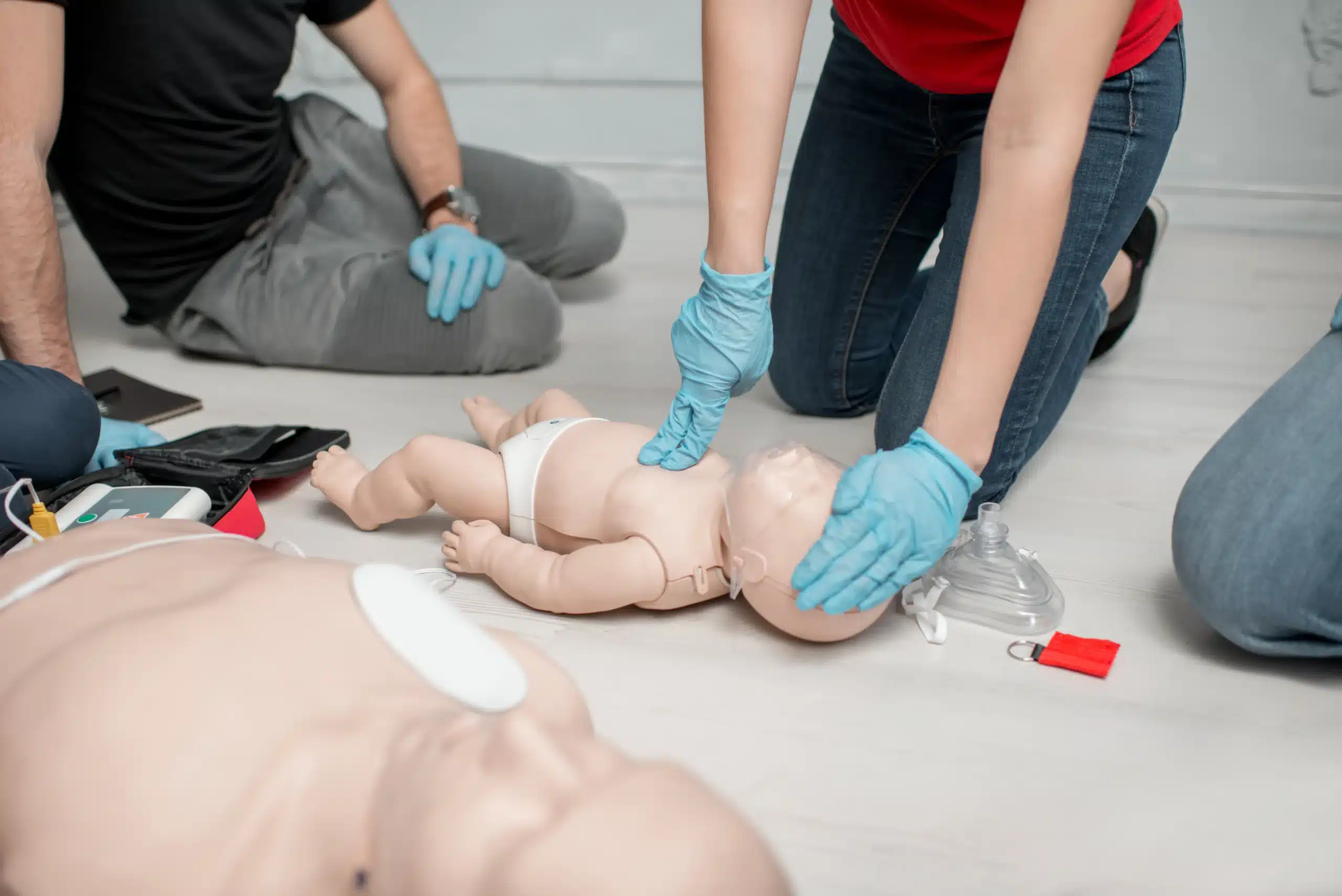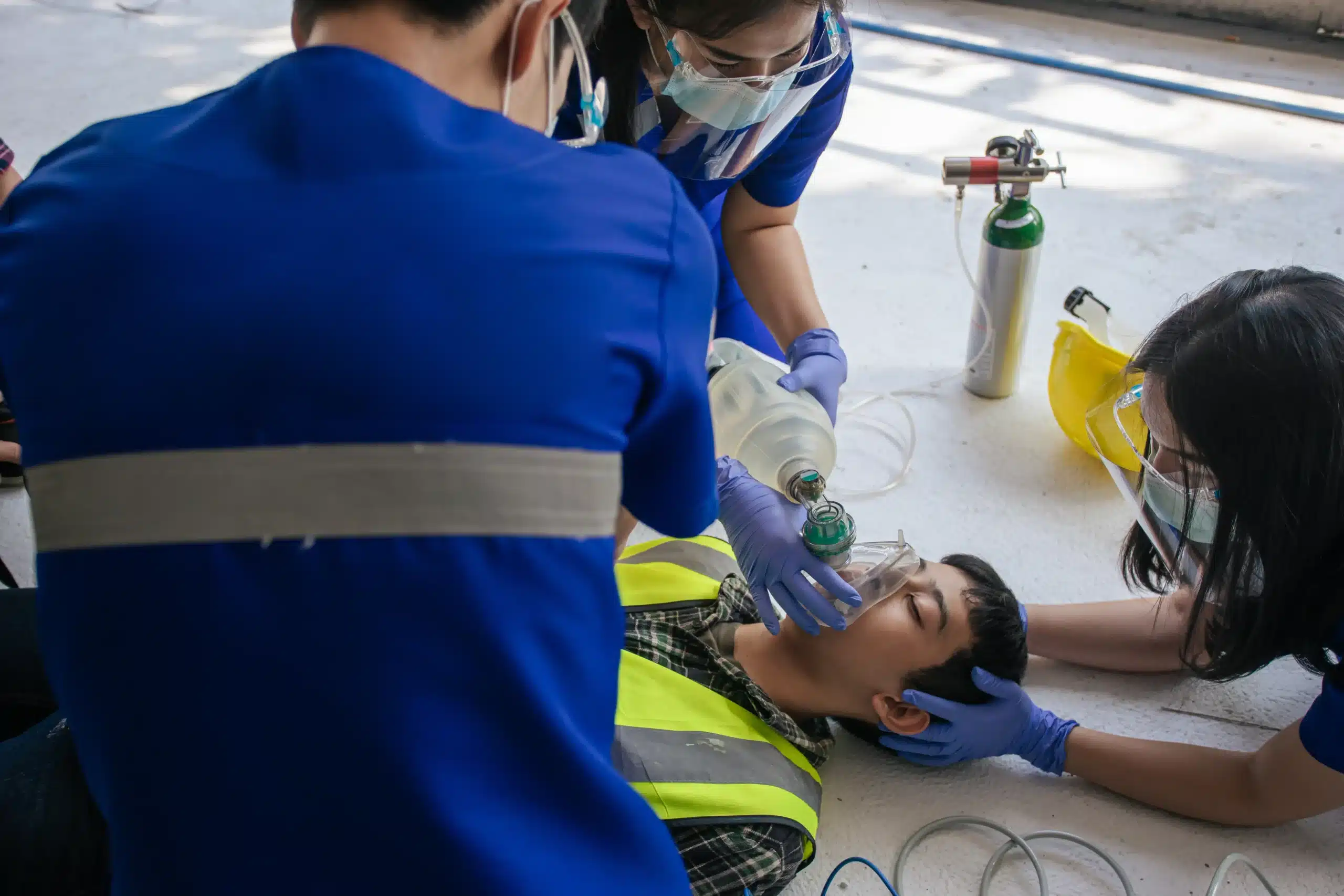Knowing CPR can make a world of difference in an emergency. If you’re searching for “Online CPR Courses Near Me,” you’re likely looking for a convenient and accessible way to learn this vital skill. This article is your go-to resource for understanding the world of online CPR training. We’ll cover everything from the different types of CPR certifications available to the process of finding a reputable provider. We’ll also discuss the benefits of online learning, such as flexibility and affordability, and address common misconceptions about online CPR courses. Plus, we’ll provide valuable tips on finding affordable training options and highlight Safety Training Seminars, a leading provider of CPR courses in Antioch, CA, and the surrounding areas.
Key Takeaways
- Online CPR courses provide flexible, affordable training: Find a course that suits your schedule and learning style, from fully online to blended learning. Choose accredited providers with comprehensive resources and skills assessments.
- Select the right course by understanding your needs: Consider your reasons for CPR certification, required certification type, and course content. Check local requirements and reviews before enrolling.
- Maintain your CPR skills with refresher courses: Regular refreshers and continuing education keep your knowledge sharp and ensure you’re prepared for emergencies.
What are Online CPR Courses?
Online CPR courses equip you with the skills to handle cardiac or breathing emergencies. They’re incredibly helpful for everyone—from coaches and parents to teens and adults—making it easy to learn life-saving skills at home. The American Red Cross highlights how accessible and convenient these courses are, letting you learn at your own speed.
Many online CPR courses use a blended learning approach, mixing online modules with in-person skill practice. This way, you can learn on your own time and still demonstrate your skills to a certified instructor. Platforms like MyCPR NOW offer similar flexibility, with courses for both beginners and healthcare professionals and exams available online 24/7. Online CPR courses offer a convenient and effective path to learning these essential skills, so you can be prepared for emergencies.
Benefits of Online CPR Courses
Online CPR courses offer several advantages, making them a popular choice. The flexibility of online learning allows you to learn at your own pace, fitting the training around your schedule. Access course materials from anywhere using your computer, tablet, or smartphone. Many programs offer access for up to two years, letting you review the information whenever you need a refresher. This is especially helpful for visual learners or those who prefer shorter study sessions.
Another key benefit is affordability. Online CPR certifications are often less expensive than traditional in-person classes, with some as low as $9.95. Plus, you receive your digital certificate and wallet card instantly after passing the exam. A physical card typically arrives by mail within a few business days. Finally, reputable online CPR courses offer comprehensive resources, including instructor materials and student support, to help you succeed.
Top Online CPR Course Providers Near You
Finding the right CPR certification course can feel overwhelming with so many options available. To help you get started, we’ve compiled a list of reputable online CPR course providers. Remember to verify that the certification meets your specific requirements, as guidelines can vary by profession and location.
American Red Cross
The American Red Cross offers a variety of online CPR training courses that are easy to access and complete. Their courses cover essential life-saving skills and prepare you to respond effectively in emergencies.
National CPR Foundation
The National CPR Foundation provides affordable online CPR, First Aid, and BLS certification. Their courses are designed to be accessible and are accepted worldwide.
American Heart Association
The American Heart Association offers comprehensive resources for CPR and ECC courses, including various training formats. Their programs are well-respected and provide essential skills for both laypersons and healthcare professionals. For those seeking in-person training and certification in Antioch, CA, Safety Training Seminars offers American Heart Association courses, including BLS, ACLS, and PALS.
ProTrainings
ProTrainings specializes in flexible online CPR and First Aid courses that allow learners to progress at their own pace. Their training is designed to be convenient and user-friendly.
American CPR Care Association
The American CPR Care Association offers accessible and affordable online CPR and First Aid training. They focus on practical skills and knowledge to prepare learners for real-life situations.
Safety Training Seminars
Safety Training Seminars provides a range of CPR and First Aid courses, including online options. They aim to make their training engaging and informative. For those located in Antioch, Brentwood, or Pittsburg, they also offer in-person classes with a low-price guarantee. Learn more about their discount group classes and their low-price guarantee.
MyCPR NOW
MyCPR NOW emphasizes affordability and only charges students upon successful course completion. This pay-upon-completion model makes it a compelling option for budget-conscious individuals.
Local Community Colleges and Universities
Many local community colleges and universities offer CPR certification courses, both online and in-person. These institutions often provide accessible training options for students and community members. Contact your local community college for more information.
Course Formats and Flexibility
CPR courses are more adaptable than ever, thanks to a range of formats designed to fit your schedule and learning style. Let’s explore some of the most common options: fully online
Fully Online Options
Fully online CPR courses offer ultimate convenience. From busy parents to on-the-go professionals, completing your training from the comfort of your home and at your own pace is a game-changer. These courses typically use a combination of videos, interactive exercises, and quizzes to teach the core concepts of CPR. While fully online options are excellent for knowledge acquisition, keep in mind that they may require an in-person skills session for official certification from organizations like the American Heart Association. This blended approach ensures you get practical experience and feedback from a certified instructor. Check with your chosen provider for specific requirements. For example, Safety Training Seminars offers the in-person skills check and certification, making it easy to complete the process.
Blended Learning
Blended learning combines the best of both worlds: online instruction and in-person practice. You’ll work through the course material online, learning at your own speed and reviewing concepts as needed. Then, you’ll attend a shorter, hands-on session with an instructor to demonstrate your skills and receive personalized feedback. This format offers flexibility while ensuring you develop the muscle memory and confidence needed to perform CPR effectively in a real-life emergency. It’s a popular choice for those who appreciate the convenience of online learning but also recognize the importance of hands-on training. Many providers, including Safety Training Seminars, offer blended learning options to cater to diverse learning styles.
Self-Paced vs. Instructor-Led
Within both fully online and blended learning formats, you’ll often encounter the distinction between self-paced and instructor-led courses. Self-paced learning allows you to progress through the material at your own rhythm, revisiting sections as needed and taking breaks when you want. This is ideal for those who prefer to learn independently and have varying time commitments. Instructor-led courses, on the other hand, follow a set schedule with live instruction and interaction with a certified instructor. This format provides real-time feedback and the opportunity to ask questions and learn from others in the class. Both approaches have their advantages, so consider your learning preferences and schedule when making your decision. If you thrive in a structured environment and enjoy group interaction, instructor-led might be a good fit. If you prefer flexibility and independent study, self-paced could be the better option. Safety Training Seminars offers both self-paced and instructor-led courses, allowing you to choose the format that best suits your needs.
Find Affordable CPR Training
Getting CPR certified doesn’t have to break the bank. There are several ways to find affordable CPR training that fits your budget. Whether you’re a student, healthcare professional, or just someone who wants to be prepared for emergencies, here’s how to find cost-effective training options:
Cost Comparison
First, do some comparison shopping. CPR training costs vary between providers. The National CPR Foundation offers online CPR, First Aid, and BLS certifications that meet OSHA guidelines and are accepted worldwide, with courses starting as low as $12.95. Knowing the general price range helps you identify a good deal. Don’t forget to check what’s included in the course fee—study materials, certification cards, and any renewal fees. Our Low Price Guarantee ensures you’re getting the best possible price in Contra Costa County for your American Heart Association certification needs. We offer classes in Antioch, Brentwood, and Pittsburg.
Discounts and Promotions
Look for discounts and promotions. The American Red Cross frequently offers promotions on training materials and courses. Check their website for current discount codes, which can sometimes offer free shipping or a percentage off your purchase. Also, see if providers offer discounts for students, military personnel, or groups. Safety Training Seminars offers discounts for group classes, a great option for businesses, community groups, or families who want to train together. We offer courses such as BLS, ACLS, and PALS.
Group Rates and Corporate Training
If you need to train a group, explore group rates and corporate training packages. Organizations like the National CPR Foundation and ECSI offer reduced rates for group registrations. This can be significantly more affordable than individual registrations. For businesses, this is a streamlined way to ensure your team is prepared for emergencies. Contact Safety Training Seminars to discuss your group training needs and get a customized quote. We can help you find the right course for your team.
Qualities of a Good Online CPR Program
Finding the right online CPR course involves more than a quick Google search. You want training that’s convenient, yes, but also high-quality and recognized by employers. Here’s what to look for:
Accreditation and Recognition
A reputable online CPR program should be accredited by a recognized organization like the American Heart Association or the American Red Cross. This ensures the program meets established standards and gives your certification credibility. The American Red Cross, for instance, emphasizes how their certification classes prepare people to handle cardiac and breathing emergencies. Accreditation demonstrates a commitment to quality training.
Course Content and Resources
Effective learning depends on comprehensive course content. A good program covers essential CPR topics—chest compressions, rescue breaths, using an AED—and provides resources you can use after the course. Look for programs offering videos, interactive simulations, downloadable guides, and access to instructors for questions. The American Red Cross notes that its CPR training covers these life-saving techniques, indicating a thorough approach. Solid course materials build your confidence and prepare you to respond effectively in a real emergency.
Skills Assessment
While online learning offers flexibility, a good CPR program still includes a hands-on component. Many organizations, including the American Red Cross, use a blended learning approach, combining online coursework with in-person skills sessions. You’ll demonstrate your abilities to a certified instructor, gaining the practical experience essential for mastering CPR techniques and receiving your certification.
Reviews and Ratings
Before committing to a course, check out reviews and ratings from past participants. Sites like the National CPR Foundation often display student feedback, offering insights into the program’s quality and effectiveness. Positive reviews can be a strong indicator of a program’s value, helping you make an informed decision. Look for comments about the clarity of the materials, the instructor’s expertise (if applicable), and the overall learning experience.
CPR Certification: Process and Validity
CPR certification confirms you’ve completed training and can perform CPR. But not all CPR certifications are the same. Understanding the process, validity, and different types of certification is important, especially if you need CPR training for your job.
Meeting Requirements
CPR classes are available in person, online, or as a blend of both. In-person classes offer hands-on training and typically lead to a two-year certification that meets Occupational Safety and Health Administration (OSHA) requirements. Online courses are convenient, but they don’t always provide the hands-on practice necessary for OSHA certification. If you need CPR certification for your workplace, make sure the course aligns with OSHA guidelines. Safety Training Seminars offers convenient in-person classes in Antioch, Brentwood, and Pittsburg.
Maintaining Certification
Most CPR certifications are valid for two years. However, some certifications, like Bloodborne Pathogens, may have a shorter validity period, often one year. To maintain your skills and ensure your certification remains current, consider taking a refresher course before it expires. Staying up-to-date with the latest CPR guidelines and techniques is crucial for providing effective assistance in emergencies.
Employer Recognition
Before enrolling in an online CPR course, confirm whether your employer will accept the certification. Not all online programs meet the requirements of every workplace. Check with your employer or HR department to understand their specific requirements for CPR certification. If you’re unsure which certification you need, contact us at Safety Training Seminars. We can help you find the right course, and we offer a low-price guarantee for our courses in Contra Costa County.
Choose the Right Online CPR Course
Finding the right online CPR course involves understanding your needs, comparing providers, and checking local requirements. Let’s break down each step to help you make the best choice.
Assess Your Needs
Before searching for “CPR classes near me,” think about why you need CPR certification. Are you a healthcare provider, a childcare worker, or simply preparing for emergencies? Different professions have different requirements. Healthcare providers often need certifications from specific organizations like the American Heart Association for BLS, ACLS, and PALS. If you want basic life support skills for personal knowledge, a more general CPR/AED certification might be enough. Knowing your needs helps narrow your search. Consider what topics you want the course to cover. The American Red Cross notes its CPR training covers essential life-saving techniques.
Compare Providers
Once you know what you need, compare different CPR course providers. Look at organizations like the National CPR Foundation, which offers online CPR, First Aid, and BLS certifications, often at affordable prices. Explore options like MyCPR NOW, which provides various certifications, including CPR/AED, First Aid, and even Pet CPR. Check out local options like community colleges or dedicated training centers like Safety Training Seminars, which offers group discounts and a low-price guarantee. Comparing providers means looking at course content, cost, format (online, blended, or in-person), and the certification offered.
Check Local Requirements
Finally, always double-check local requirements. While online CPR courses are convenient, some professions or situations require hands-on, in-person training. The American Red Cross states that online-only courses don’t provide the hands-on skills needed for OSHA compliance. If your job requires OSHA-compliant certification, you’ll likely need an in-person or blended learning course. Ensure the certification you choose aligns with any workplace or regulatory requirements. This is especially important for healthcare professionals and those in safety-sensitive positions.
Online CPR Training: Common Misconceptions
Online CPR training offers a convenient way to learn lifesaving skills, but it’s important to separate fact from fiction. One common misconception is that online-only courses fulfill all certification requirements. While convenient, these courses typically don’t include the hands-on skills assessment required by many employers and licensing boards. Organizations like the American Red Cross clearly state this on their websites. If your workplace mandates a practical skills evaluation, consider blended learning or traditional in-person classes. These formats combine online learning with essential hands-on practice guided by a certified instructor.
Another misconception is that simply having any CPR certification is sufficient. While the CDC encourages providing CPR—even with an expired certification—in emergencies, maintaining a current certification is crucial. It demonstrates a commitment to best practices and ensures you’re up-to-date on the latest guidelines. Think of it like a driver’s license—renewing it keeps you legally compliant and reflects your commitment to safe driving. Regularly refreshing your CPR skills through refresher courses ensures you can respond confidently and effectively. So, while online CPR training offers a valuable foundation, remember that staying current with your certification through in-person training is key.
Refresher Courses and Continuing Education
Staying up-to-date on CPR best practices is crucial, especially if you’re already certified. Regular refreshers help you maintain those life-saving skills and keep your knowledge sharp. Organizations like the American Red Cross and the American Heart Association offer refresher courses designed specifically for recertification, ensuring you’re always ready to respond effectively in an emergency. These courses not only reinforce essential skills but also cover any updates to emergency protocols. It’s a good idea to check with your certifying organization for their recommended refresher schedule. Safety Training Seminars offers a variety of refresher courses aligned with American Heart Association guidelines.
Many refresher courses also offer continuing education units (CEUs). This is a huge plus for professionals in fields like healthcare, education, and emergency services, where ongoing training is often required. Earning CEUs while refreshing your CPR skills is a smart way to stay compliant and boost your professional development. Check with your licensing board or professional organization to understand their CEU requirements.
If you need a more flexible option, look into blended learning CPR courses. These courses combine online learning with in-person skill sessions. You can work through the online portion at your own pace, then attend a hands-on session to practice your technique and get feedback from an instructor. This format is perfect for busy schedules and offers the best of both worlds. Blended learning courses are available through various providers, including the American Red Cross.
Related Articles
- Find CPR Courses Near Me: A Practical Guide – Antioch CPR Classes
- Online CPR Classes in Brentwood: Your Complete Guide – Antioch CPR Classes
- CPR Certification Near Me: Your Complete Guide – Antioch CPR Classes
- CPR Courses in Pittsburg: Your Complete Guide – Antioch CPR Classes
- CPR Training in Brentwood: Your Complete Guide – Antioch CPR Classes
Frequently Asked Questions
Is online CPR certification enough, or do I need in-person training?
It depends on your specific needs. Fully online CPR courses are great for learning the basics, but many workplaces and licensing boards require an in-person skills assessment. Blended learning courses, which combine online learning with in-person practice, are a good way to meet these requirements. Check with your employer or licensing board to confirm their specific requirements.
How long is CPR certification valid, and how do I renew it?
Most CPR certifications are valid for two years. To renew, you’ll need to take a refresher course before your current certification expires. This ensures your skills are up-to-date and you’re familiar with the latest guidelines.
How much does CPR certification cost, and are there ways to save money?
The cost of CPR certification varies depending on the provider and the type of course. Look for discounts for students, groups, or corporate training. Some providers also offer promotions or discounts for online courses. Comparing prices and checking for discounts can help you find an affordable option.
What’s the difference between CPR certification from the American Heart Association, American Red Cross, and other providers?
Different organizations offer CPR certification based on their own standards and guidelines. While the core skills taught are similar, there might be variations in the specific techniques or protocols. Check with your employer or licensing board to see if they require certification from a particular organization.
How do I choose the right online CPR course for me?
Consider why you need CPR certification, your learning style, and your budget. Look for accredited programs with comprehensive content, skills assessments, and positive reviews. If you need certification for work, ensure the course meets your employer’s requirements. If you prefer a flexible schedule, a self-paced online course might be a good fit. If you value instructor interaction, consider a blended learning format.








